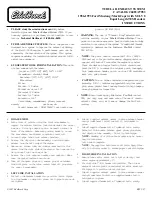
Here are some tips on getting the most out of your child
restraint:
•
Before buying any restraint system, make sure that it
has a label certifying that it meets all applicable Safety
Standards. We also recommend that you make sure
that you can install the child restraint in the vehicle
where you will use it, before you buy it.
•
The restraint must be appropriate for your child’s
weight and height. Check the label on the restraint for
weight and height limits.
•
Carefully follow the instructions that come with the
restraint. If you install the restraint improperly, it may
not work when you need it.
The passenger seat belts are equipped with either
cinching latch plates or seat belt retractors that can be
switched to an automatic locking mode, which are
designed to keep the lap portion tight around the child
restraint so that it is not necessary to use a locking clip.
If the seat belt has a cinching latch plate, pulling up on
the shoulder portion of the lap/shoulder belt will
tighten the belt. The cinching latch plate will keep the
belt tight, however, any seat belt system will loosen
with time, so check the belt occasionally and pull it
tight if necessary.
If the seat belt has a switchable retractor, it will have a
distinctive label. To operate the switchable retractor,
please refer to Automatic-Locking Retractor (ALR) in
this section.
•
In the rear seat, you may have trouble tightening the
lap/shoulder belt on the child restraint because the
buckle or latch plate is too close to the belt path
opening on the restraint. Disconnect the latch plate
from the buckle and twist the short buckle end of the
belt several times to shorten it. Insert the latch plate
into the buckle with the release button facing out.
•
If the belt still can’t be tightened, or if by pulling and
pushing on the restraint loosens the belt, disconnect
the latch plate from the buckle, turn the latch plate
around, and insert the latch plate into the buckle
again. If you still can’t make the child restraint secure,
try a different seating position.
56
THINGS TO KNOW BEFORE STARTING YOUR VEHICLE
Summary of Contents for 2007 Caliber
Page 2: ......
Page 5: ...INTRODUCTION 5 1...
Page 64: ......
Page 89: ...UNDERSTANDING THE FEATURES OF YOUR VEHICLE 89 3...
Page 90: ...90 UNDERSTANDING THE FEATURES OF YOUR VEHICLE...
Page 91: ...UNDERSTANDING THE FEATURES OF YOUR VEHICLE 91 3...
Page 129: ...Removing Flashlight Three Press Switch UNDERSTANDING THE FEATURES OF YOUR VEHICLE 129 3...
Page 141: ...INSTRUMENT PANEL FEATURES UNDERSTANDING YOUR INSTRUMENT PANEL 141 4...
Page 142: ...INSTRUMENT CLUSTER BASE 142 UNDERSTANDING YOUR INSTRUMENT PANEL...
Page 143: ...INSTRUMENT CLUSTER PREMIUM UNDERSTANDING YOUR INSTRUMENT PANEL 143 4...
Page 203: ...Operating Tips UNDERSTANDING YOUR INSTRUMENT PANEL 203 4...
Page 232: ...232 STARTING AND OPERATING...
Page 279: ...ENGINE COMPARTMENT GASOLINE ENGINES MAINTAINING YOUR VEHICLE 279 7...
Page 345: ...INDEX 10...
Page 360: ...NOTES...
















































